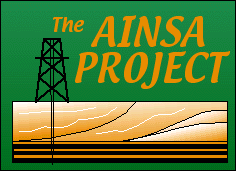 The Ainsa
The AinsaDeep-water
Channel Project
 The Ainsa
The Ainsa
Deep-water
Channel Project
![]() Introduction:-
Introduction:-
![]() Rationale
Rationale
![]() Project
Background
Project
Background
![]() Data
Acquisition
Data
Acquisition
![]() Introduction to the Ainsa Channel System
Introduction to the Ainsa Channel System
![]()
An integrated outcrop/sub-surface study is being carried out on the Ainsa I and II deep-water channel system, Spanish Pyrenees. This project resulted from a series of meetings held in 1996 by six oil companies in collaboration with the NPD (Norwegian Petroleum Directorate), which comprises the FORCE Deep Water Clastics Workgroup. The project evolved to a consortia-based research study based in the Department of Geological Sciences at University College London.
The aim of this project is to integrate outcrop data with new sub-surface information in order to derive more sophisticated depositional models for submarine channel development. The results of this research include the provision of an outcrop analogue which will be applicable to many hydrocarbon reservoirs.
![]()
Field observations of ancient successions can provide detailed descriptions of the micro- to meso-scale features, such as facies, vertical sequences and detailed bedding geometry/contact relationships. The sub-surface description of deep-water reservoirs (e.g., from oil company data sets) is commonly restricted to the identification of larger scale (seismic) features. This research project is one of the first fully-integrated studies aimed at bridging the gap between sub-surface reservoir data and outcrop-scale data.
In order to enhance the understanding of deep-water clastic systems, and to enable the upscaling and improvement of existing depositional models, it is necessary to acquire a panoply of data-sets, such as those obtained from continuous sediment cores, wireline logs and seismic profiles. The calibration of ancient outcrops with downhole sedimentary logs and seismic data provides a powerful tool for the elucidation of the 3D architecture of deep-water channel systems.
![]()
Sediment Core Data
• Successful
drilling of six holes through the Ainsa I and II channel
complexes, to a depth of ~250m each, was carried out with about a
96% core recovery.
• Micropalaeontological and palynological age dating of the
cores is underway.
• Detailed core
descriptions are available to the consortium at a resolution of
1:50 and 1:500 scale, and are currently being refined to a 1:1
scale.
• A suite of wireline logs has been successfully obtained
from all holes.
Seismic Profiles
• Following a test seismic line, further seismic profiling is taking place.
![]()
![]() Introduction to the Ainsa Channel System
Introduction to the Ainsa Channel System
The Ainsa Channel System, south-central Pyrenees, occurs in the oldest part of the Campodarbe Group, and it is of Upper Eocene age. The Ainsa Channel Complex is perhaps the most famous of the submarine channel outcrops within Western Europe. The Ainsa channels consist of two principal channel complexes (Ainsa I and Ainsa II) which are separated by thin- and very thin-bedded sandy turbidites and marls. The Ainsa I Channel Complex is an example of an erosional-depositional system. The Ainsa II Channel Complex contains significant erosional cut-downs, with infill of essentially non-erosive sandy facies. The channel dimensions are at a seismic scale.
Further References:-
Pickering, K.T., Hiscott, R.N., Kenyon, N.H., Ricci
Lucchi, F. & Smith, R.D.A. 1995. Atlas of Deep
Water Environments: Architectural style in turbidite systems.
London: Chapman & Hall, 333 pp. ISBN 0-412-56110-7.
Clark, J.D. & Pickering, K.T. 1996. Architectural elements and growth patterns of
submarine channels: application to hydrocarbon exploration. The
American Association of Petroleum Geologists Bulletin, 80,
194-221.
Clark, J.D. and Pickering, K.T., 1996. Submarine
Channels: Processes and Architecture. Vallis Press,
London.
![]()